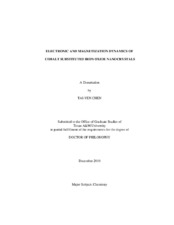| dc.contributor.advisor | Son, Dong Hee | |
| dc.creator | Chen, Tai-Yen | |
| dc.date.accessioned | 2011-02-22T22:24:39Z | |
| dc.date.accessioned | 2011-02-22T23:49:59Z | |
| dc.date.available | 2011-02-22T22:24:39Z | |
| dc.date.available | 2011-02-22T23:49:59Z | |
| dc.date.created | 2010-12 | |
| dc.date.issued | 2011-02-22 | |
| dc.date.submitted | December 2010 | |
| dc.identifier.uri | https://hdl.handle.net/1969.1/ETD-TAMU-2010-12-8838 | |
| dc.description.abstract | Knowledge of energy dissipation and relaxation in electron, spin, and lattice degrees of freedom is of fundamental importance from both a technological and scientific point of view. In this dissertation, the electronic and magnetization dynamics of photoexcited colloidal cobalt substituted iron oxide nanocrystals, CoxFe3-xO4, were investigated through transient absorption and pump-probe Faraday rotation measurements.
In this dissertation, linearly polarized femtosecond optical pulses at 780 nm were used to excite the weak absorption originating from the intervalence charge transfer transition (IVCT) between Fe2+ and Fe3+ ions of Fe3O4 nanocrystals. The timescale and corresponding relaxation processes of electronic relaxation dynamics of the excited IVCT state were first discussed. Size effect on electronic relaxation dynamics in Fe3O4 nanocrystals is not distinct on the basis of result from this study. One interesting feature of electronic dynamics data of photoexcited Fe3O4 nanocrystals is the creation of coherent acoustic phonons. Information on lattice temperature was obtained by measuring the period of coherent acoustic phonon as a function of excitation fluence and fit into a simple model based on Lamb’s theory. Since optical control of the magnetization can be either through optical or heating mechanisms, quantitative estimation of degree of demagnetization caused by lattice temperature is made by using Langevin function. The result from such estimation indicates the effect of lattice temperature rise on magnetization is too small to significantly affect the magnetization of Fe3O4 nanocrystals.
Magnetization dynamics were studied via pump-probe Faraday rotation measurements. Optical excitation with near-infrared pulse resulted in an ultrafast demagnetization in 100fs. The energy of the excited state then relaxed through spin-lattice relaxation (SLR). Effects of surface spin and chemical tuning on the SLR were investigated by comparing the magnetization recovery timescales of nanocrystal with different particle sizes and cobalt concentration respectively. The experimental result is explained by a simple model where interior and surface spins contributed to the spin-lattice relaxation process differently. The observations suggest that spin-orbit coupling of the surface is stronger and less sensitive to stoichiometric variation than the interior spins of the nanocrystals. | en |
| dc.format.mimetype | application/pdf | |
| dc.language.iso | en_US | |
| dc.subject | Iron oxide nanocrystals | en |
| dc.subject | Dynamics | en |
| dc.subject | Magnetization | en |
| dc.subject | Faraday rotation | en |
| dc.subject | Spin-lattice relaxation | en |
| dc.subject | Lattice temperature | en |
| dc.title | Electronic and Magnetization Dynamics of Cobalt Substituted Iron Oxide Nanocrystals | en |
| dc.type | Book | en |
| dc.type | Thesis | en |
| thesis.degree.department | Chemistry | en |
| thesis.degree.discipline | Chemistry | en |
| thesis.degree.grantor | Texas A&M University | en |
| thesis.degree.name | Doctor of Philosophy | en |
| thesis.degree.level | Doctoral | en |
| dc.contributor.committeeMember | Cremer, Paul S. | |
| dc.contributor.committeeMember | North, Simon W. | |
| dc.contributor.committeeMember | Schuessler, Hans A. | |
| dc.type.genre | Electronic Dissertation | en |
| dc.type.material | text | en |


